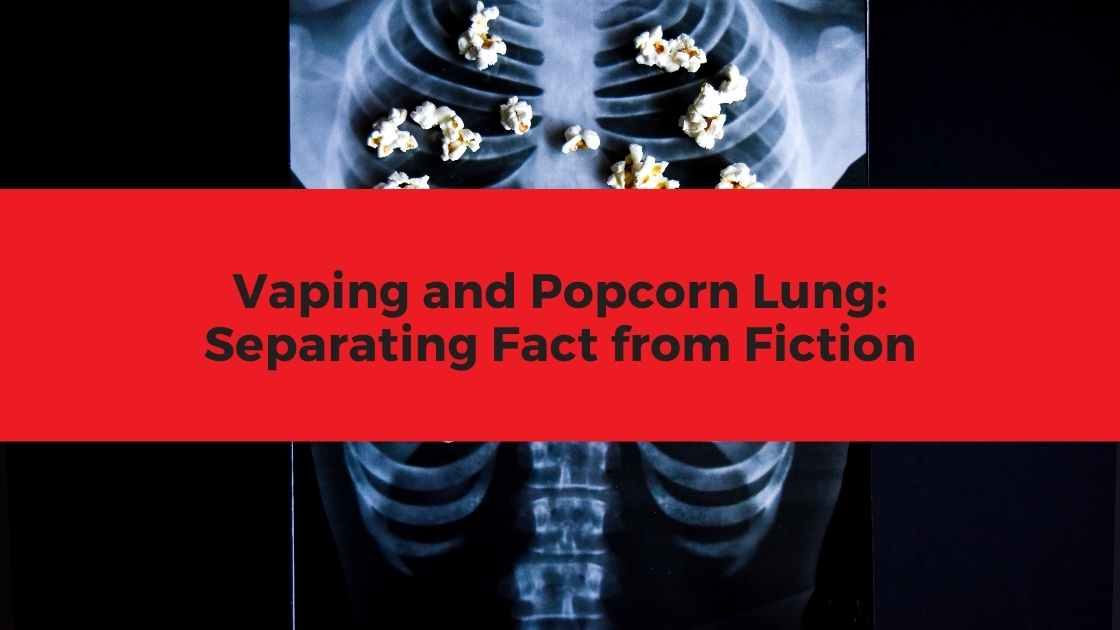Vaping and Popcorn Lung: Separating Fact from Fiction
In recent years, concerns about the potential link between e-cigarette use (vaping) and bronchiolitis obliterans—commonly known as “popcorn lung”—have gained significant media attention. Headlines suggesting a direct causal relationship have raised alarms among public health officials and consumers alike. But what does the scientific evidence actually tell us about this relationship? This article examines the claims, evaluates the evidence, and provides a balanced perspective on what we currently know.
Understanding Popcorn Lung
Bronchiolitis obliterans is a rare and serious lung condition characterized by scarring of the small airways (bronchioles), which can lead to breathing difficulties. It earned the nickname “popcorn lung” after cases were identified among workers in microwave popcorn factories who were exposed to high levels of diacetyl, a chemical used to create butter flavouring.[1]
Symptoms of popcorn lung include:
- Persistent coughing
- Shortness of breath
- Wheezing
- Fatigue
- Fever and night sweats in some cases[2]
The Vaping Connection: Examining the Evidence
Diacetyl in E-Cigarettes
The concern about vaping and popcorn lung stems primarily from the presence of diacetyl in some e-liquid formulations. However, several important factors need to be considered:
- Regulatory differences: Diacetyl has been banned in e-cigarette liquids in the UK and EU since 2016 under the EU Tobacco Products Directive. It remains present in some US products, highlighting significant regional differences in potential exposure.[3]
- Concentration levels: Scientific studies, including a 2015 Harvard study, found that traditional cigarettes contain approximately 336 micrograms of diacetyl per cigarette, compared to an average of 9 micrograms per e-cigarette cartridge. This means a pack-a-day smoker would have 750 times more exposure than someone using e-cigarettes, yet popcorn lung is not commonly associated with traditional smoking.[4]
What Health Authorities Say
Several authoritative health organisations have addressed this specific concern:
- Cancer Research UK explicitly states there have been “no confirmed cases of popcorn lung linked to e-cigarettes.”[5]
- The NHS in the UK asserts that “vaping does not cause ‘popcorn lung,'” noting that diacetyl is banned in UK-regulated nicotine vapes and e-liquids.[6]
- The CDC reports on vaping-related lung injuries (EVALI), but these are primarily linked to vitamin E acetate in THC-containing products, not diacetyl or popcorn lung.[7]
Case Studies: Anecdotal vs. Clinical Evidence
Media reports often cite individual cases, such as a 17-year-old who vaped daily for three years and developed bronchiolitis obliterans. While concerning, these anecdotal reports have significant limitations as evidence for a causal relationship:
- Popcorn lung can result from multiple causes, including toxic chemical exposure, infections, and autoimmune diseases.[8]
- Without detailed investigation, attributing such cases solely to vaping is speculative.
- The Canadian Medical Association Journal (CMAJ) argues that blaming vaping for popcorn lung is questionable, given the low diacetyl levels in e-cigarettes compared to traditional cigarettes.[9]
The Broader Context of Vaping Risks
While the evidence doesn’t support a direct link between regulated vaping products and popcorn lung, this doesn’t mean vaping is risk-free. Other concerns include:
- Increasing use among young people who might never have smoked
- Potential for nicotine addiction
- Other respiratory issues that may be associated with vaping
- Risks from unregulated or black market products[10]
The UK government has announced plans to ban disposable vapes from June 2025, primarily in response to youth vaping concerns rather than specific popcorn lung risks.[11]
Conclusion: A Balanced Perspective
Based on current evidence, the claim that vaping directly causes popcorn lung appears to be overstated. Key points to remember:
- No confirmed cases of popcorn lung have been linked to e-cigarette use.
- Diacetyl is banned in UK and EU vaping products.
- Traditional cigarettes contain significantly higher levels of diacetyl than e-cigarettes, yet aren’t commonly associated with popcorn lung.
- Individual cases attributed to vaping may have alternative explanations or contributing factors.
However, this doesn’t mean vaping is without risks. The long-term health effects of e-cigarette use are still being studied, and caution is warranted, particularly among young people and non-smokers.[12]
For those concerned about vaping risks, the most prudent approach is to:
- Avoid black market or unregulated products
- Consider regulated alternatives if using vaping as a smoking cessation tool
- Consult healthcare professionals about smoking cessation strategies
- Stay informed about emerging research on vaping health effects
By maintaining a nuanced, evidence-based perspective on vaping risks, we can make more informed decisions about personal health while supporting effective public health messaging that neither understates nor exaggerates potential dangers.
References
[1] Cleveland Clinic. (2023). Popcorn Lung: Causes, Symptoms, Treatment & Is It Real. https://my.clevelandclinic.org/health/diseases/24587-popcorn-lung
[2] Cleveland Clinic. (2023). Popcorn Lung: Causes, Symptoms, Treatment & Is It Real. https://my.clevelandclinic.org/health/diseases/24587-popcorn-lung
[3] European Union. (2016). EU Tobacco Products Directive. https://ec.europa.eu/health/tobacco/products_en
[4] Allen, J. G., et al. (2015). Flavoring Chemicals in E-Cigarettes: Diacetyl, 2,3-Pentanedione, and Acetoin in a Sample of 51 Products, Including Fruit-, Candy-, and Cocktail-Flavored E-Cigarettes. Environmental Health Perspectives. https://ehp.niehs.nih.gov/doi/10.1289/ehp.1510185
[5] Cancer Research UK. (2022). Does vaping cause popcorn lung? https://www.cancerresearchuk.org/about-cancer/causes-of-cancer/does-vaping-cause-popcorn-lung
[6] NHS. (2023). Vaping myths and facts. https://www.nhs.uk/better-health/quit-smoking/vaping-to-quit-smoking/
[7] Centers for Disease Control and Prevention. (2023). Electronic Cigarettes (E-cigarettes). https://www.cdc.gov/tobacco/basic_information/e-cigarettes/index.htm
[8] Cleveland Clinic. (2023). Popcorn Lung: Causes, Symptoms, Treatment & Is It Real. https://my.clevelandclinic.org/health/diseases/24587-popcorn-lung
[9] Stanbrook, M.B., et al. (2019). RE: Vape related “Popcorn Lung” debunked years ago. CMAJ. https://www.cmaj.ca/content/re-vape-related-popcorn-lung-debunked-years-ago
[10] FDA. (2024). Electronic Cigarettes. https://www.fda.gov/tobacco-products/products-ingredients-components/e-cigarettes-vapes-and-other-electronic-nicotine-delivery-systems-ends
[11] UK Government. (2024). Press release: Government to ban disposable vapes to protect children’s health and the environment. https://www.gov.uk/government/news/government-to-ban-disposable-vapes-to-protect-childrens-health-and-the-environment
[12] National Academies of Sciences, Engineering, and Medicine. (2018). Public Health Consequences of E-Cigarettes. https://www.nap.edu/catalog/24952/public-health-consequences-of-e-cigarettes
This article aims to provide balanced information based on current scientific understanding and official health guidance.



Comments are closed here.